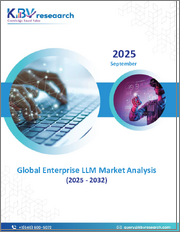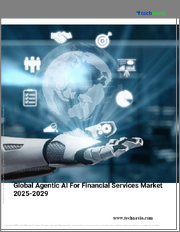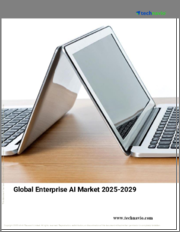
|
시장보고서
상품코드
1782434
세계의 기업 AI 시장 조사 보고서 : 산업 분석, 규모, 점유율, 성장, 동향, 예측(2025-2033년)Global Enterprise Artificial Intelligence Market Research Report- Industry Analysis, Size, Share, Growth, Trends and Forecast 2025 to 2033 |
||||||
세계의 기업 AI 시장 규모는 2024년 287억 달러에서 2033년에는 5,182억 2,000만 달러로 성장하며, 2026-2033년의 예측 기간 중 37.92%의 견고한 연평균 성장률(CAGR)을 보일 것으로 예측됩니다.
기업용 AI 시장은 업무 효율화와 혁신 추진에 있으며, AI 기술의 혁신 가능성을 인식하는 기업이 늘어나면서 전례 없는 성장세를 보이고 있습니다. 방대한 양의 데이터를 분석하고 실용적인 인사이트를 도출하는 능력을 갖춘 AI는 다양한 분야의 비즈니스 전략에 필수적인 요소로 자리 잡고 있습니다. 일상적인 업무 자동화부터 의사결정 프로세스 강화에 이르기까지 기업 AI 솔루션을 통해 조직은 업무를 최적화하고 전반적인 성과를 향상시킬 수 있습니다. 기업이 AI 기능에 대한 투자를 지속하면서 생산성과 경쟁력을 강화하는 지능형 솔루션에 대한 수요에 힘입어 시장이 크게 확대될 것으로 예측됩니다.
또한 기업 용도에 AI를 통합함으로써 조직이 고객과 상호 작용하고 자원을 관리하는 방식을 재구성하고 있습니다. 챗봇, 가상 비서 등 AI 기반 툴은 고객 서비스 업무를 간소화하고 즉각적인 지원과 개인화된 경험을 제공합니다. 또한 예측 분석과 머신러닝 알고리즘은 기업이 동향을 예측하고, 공급망을 최적화하고, 마케팅 전략을 강화할 수 있는 능력을 부여하고 있습니다. 이러한 기술이 발전함에 따라 기업은 변화하는 시장 역학 및 소비자 선호도에 적응할 수 있게 되어 중요한 역할을 하게 될 것입니다.
또한 데이터 보안과 컴플라이언스에 대한 관심이 높아지면서 기업 환경에서 AI 솔루션의 도입이 증가하고 있습니다. 조직은 사이버 보안 대책 강화, 이상 징후 감지, 위험 감소를 위해 AI를 활용하고 있습니다. 규제 프레임워크가 진화하고 데이터 프라이버시에 대한 우려가 커짐에 따라 컴플라이언스를 보장하고 기밀 정보를 보호하는 데 있으며, AI의 역할이 점점 더 중요해지고 있습니다. 이처럼 기업 AI 시장은 점점 더 복잡해지는 비즈니스 환경에서 혁신, 효율성, 보안에 대한 필요성에 힘입어 큰 성장이 예상됩니다.
이 보고서는 다양한 산업과 시장에 대한 종합적이고 실용적인 인사이트를 제공할 수 있도록 세심하게 작성되었습니다. 각 보고서는 시장 상황을 완전히 이해하기 위해 몇 가지 중요한 요소를 포함하고 있습니다.
시장 개요: 정의, 분류, 산업 현황 등 시장에 대한 자세한 소개.
시장 역학: 시장 성장에 영향을 미치는 주요 촉진요인, 억제요인, 기회 및 과제를 상세하게 분석합니다. 이 섹션에서는 기술 발전, 규제 변화, 새로운 동향 등의 요인을 살펴봅니다.
세분화 분석 : 제품 유형, 용도, 최종사용자, 지역 등의 기준에 따라 시장을 명확한 부문으로 세분화합니다. 이 분석을 통해 각 부문의 실적과 미래성을 파악할 수 있습니다.
경쟁 구도: 시장 점유율, 제품 포트폴리오, 전략적 구상, 재무 실적 등 주요 시장 기업에 대한 종합적인 평가. 주요 기업이 채택하고 있는 경쟁 역학 및 주요 전략에 대한 인사이트을 제공합니다.
시장 예측 : 과거 데이터와 현재 시장 상황을 바탕으로 일정 기간 시장 규모와 성장 추세를 예측합니다. 여기에는 정량적 분석과 미래 시장 궤적을 보여주는 그래프 표시가 포함됩니다.
지역별 분석 : 지역별 시장 성과를 평가하고 주요 시장 및 지역 동향을 파악합니다. 지역 시장 역학 및 비즈니스 기회를 이해하는 데 도움이 됩니다.
새로운 동향과 기회 : 현재 시장 동향과 새로운 시장 동향, 기술 혁신, 잠재적 투자 대상 분야를 파악합니다. 미래 시장 개발과 성장 전망에 대한 인사이트를 제공합니다.
목차
제1장 서문
제2장 개요
- 시장의 하이라이트
- 세계 시장 스냅숏
제3장 기업 AI 산업 분석
- 서론 : 시장 역학
- 시장 성장 촉진요인
- 시장 성장 억제요인
- 기회
- 업계 동향
- Porter's Five Forces 분석
- 시장의 매력 분석
제4장 밸류체인 분석
- 밸류체인 분석
- 원재료 분석
- 원재료 리스트
- 원재료 제조업체 리스트
- 주요 원재료의 가격 동향
- 잠재적 바이어 리스트
- 마케팅 채널
- 다이렉트 마케팅
- 인다이렉트 마케팅
- 마케팅 채널 발전 동향
제5장 세계의 기업 AI 시장 분석 : 컴포넌트별
- 컴포넌트별 개요
- 컴포넌트별 과거 및 예측 데이터 분석
- 솔루션
- 서비스별
제6장 세계의 기업 AI 시장 분석 : 기술별
- 기술별 개요
- 기술별 과거 및 예측 데이터 분석
- 기계학습과 딥러닝
- 자연언어처리(NLP)
제7장 세계의 기업 AI 시장 분석 : 용도 분야별
- 용도 분야별 개요
- 용도 분야별 과거 및 예측 데이터 분석
- 보안과 리스크 관리
- 마케팅 관리
- 고객 지원과 경험
- 인사·채용 관리
- 분석 애플리케이션
- 프로세스 자동화
제8장 세계의 기업 AI 시장 분석 : 배포 유형별
- 배포 유형별 개요
- 배포 유형별 과거 및 예측 데이터 분석
- 클라우드
- 온프레미스
제9장 세계의 기업 AI 시장 분석 : 조직 규모별
- 조직 규모별 개요
- 조직 규모별 과거 및 예측 데이터 분석
- 중소기업(SMB)
- 대기업
제10장 세계의 기업 AI 시장 분석 : 지역별
- 지역별 전망
- 서론
- 북미의 판매 분석
- 개요, 실적과 예측
- 북미 : 부문별
- 북미 국가별
- 미국
- 캐나다
- 멕시코
- 유럽의 판매 분석
- 개요, 실적과 예측
- 유럽 부문별
- 유럽 국가별
- 영국
- 프랑스
- 독일
- 이탈리아
- 러시아
- 기타 유럽
- 아시아태평양의 판매 분석
- 개요, 실적과 예측
- 아시아태평양 부문별
- 아시아태평양 국가별
- 중국
- 인도
- 일본
- 한국
- 호주
- 동남아시아
- 기타 아시아태평양
- 라틴아메리카의 판매 분석
- 개요, 실적과 예측
- 라틴아메리카 : 부문별
- 라틴아메리카 국가별
- 브라질
- 아르헨티나
- 페루
- 칠레
- 기타 라틴아메리카
- 중동 및 아프리카의 판매 분석
- 개요, 실적과 예측
- 중동 및 아프리카 부문별
- 중동 및 아프리카 국가별 리스트
- 사우디아라비아
- 아랍에미리트
- 이스라엘
- 남아프리카공화국
- 기타 중동 및 아프리카
제11장 기업 AI 기업의 경쟁 구도
- 기업 AI 시장의 경쟁 정보
- 제휴·협력·합의
- 합병·인수
- 신제품 발표
- 기타 개발
제12장 기업 개요
- 상위 기업의 시장 점유율 분석
- 시장 집중도
- IBM
- Microsoft
- AWS
- Intel
- SAP
- Sentient Technologies
- Oracle
- HPE
- Wipro
Global Enterprise Artificial Intelligence Market size is anticipated to grow from USD 28.7 Billion in 2024 to USD 518.22 Billion by 2033, showcasing a robust Compound Annual Growth Rate (CAGR) of 37.92% during the forecast period of 2026 to 2033.
The enterprise artificial intelligence market is experiencing unprecedented growth as organizations increasingly recognize the transformative potential of AI technologies in driving operational efficiency and innovation. With the ability to analyze vast amounts of data and generate actionable insights, AI is becoming an integral component of business strategies across various sectors. From automating routine tasks to enhancing decision-making processes, enterprise AI solutions are enabling organizations to optimize their operations and improve overall performance. As businesses continue to invest in AI capabilities, the market is expected to expand significantly, driven by the demand for intelligent solutions that enhance productivity and competitiveness.
Moreover, the integration of AI into enterprise applications is reshaping the way organizations interact with customers and manage resources. AI-powered tools, such as chatbots and virtual assistants, are streamlining customer service operations, providing instant support and personalized experiences. Additionally, predictive analytics and machine learning algorithms are empowering businesses to forecast trends, optimize supply chains, and enhance marketing strategies. As these technologies evolve, they will play a crucial role in enabling organizations to adapt to changing market dynamics and consumer preferences.
Furthermore, the growing emphasis on data security and compliance is driving the adoption of AI solutions in enterprise environments. Organizations are increasingly leveraging AI to enhance cybersecurity measures, detect anomalies, and mitigate risks. As regulatory frameworks evolve and data privacy concerns intensify, the role of AI in ensuring compliance and safeguarding sensitive information will become increasingly vital. The enterprise artificial intelligence market is thus positioned for significant growth, driven by the need for innovation, efficiency, and security in an increasingly complex business landscape.
Our reports are meticulously crafted to provide clients with comprehensive and actionable insights into various industries and markets. Each report encompasses several critical components to ensure a thorough understanding of the market landscape:
Market Overview: A detailed introduction to the market, including definitions, classifications, and an overview of the industry's current state.
Market Dynamics: In-depth analysis of key drivers, restraints, opportunities, and challenges influencing market growth. This section examines factors such as technological advancements, regulatory changes, and emerging trends.
Segmentation Analysis: Breakdown of the market into distinct segments based on criteria like product type, application, end-user, and geography. This analysis highlights the performance and potential of each segment.
Competitive Landscape: Comprehensive assessment of major market players, including their market share, product portfolio, strategic initiatives, and financial performance. This section provides insights into the competitive dynamics and key strategies adopted by leading companies.
Market Forecast: Projections of market size and growth trends over a specified period, based on historical data and current market conditions. This includes quantitative analyses and graphical representations to illustrate future market trajectories.
Regional Analysis: Evaluation of market performance across different geographical regions, identifying key markets and regional trends. This helps in understanding regional market dynamics and opportunities.
Emerging Trends and Opportunities: Identification of current and emerging market trends, technological innovations, and potential areas for investment. This section offers insights into future market developments and growth prospects.
SEGMENTATION COVERED IN THE REPORT
By Component
- Solution
- Services
By Technology
- Machine learning and deep learning
- Natural Language Processing (NLP)
By Application Area
- Security and risk management
- Marketing management
- Customer support and experience
- Human resource and recruitment management
- Analytics application
- Process automation
By Deployment Type
- Cloud
- On-premises
By Organization Size
- Small and Medium-sized Businesses (SMBs)
- Large enterprises
- COMPANIES PROFILED
- IBM
- Microsoft
- AWS
- Intel
- SAP
- Sentient Technologies
- Oracle
- HPE
- Wipro
- The above list can be customized.
TABLE OF CONTENTS
1. PREFACE
- 1.1. Report Description
- 1.1.1 Objective
- 1.1.2 Target Audience
- 1.1.3 Unique Selling Proposition (USP) & offerings
- 1.2. Research Scope
- 1.3. Research Methodology
- 1.3.1 Market Research Process
- 1.3.2 Market Research Methodology
2. EXECUTIVE SUMMARY
- 2.1. Highlights of Market
- 2.2. Global Market Snapshot
3. ENTERPRISE ARTIFICIAL INTELLIGENCE INDUSTRY ANALYSIS
- 3.1. Introduction - Market Dynamics
- 3.2. Market Drivers
- 3.3. Market Restraints
- 3.4. Opportunities
- 3.5. Industry Trends
- 3.6. Porter's Five Force Analysis
- 3.7. Market Attractiveness Analysis
- 3.7.1 Market Attractiveness Analysis By Component
- 3.7.2 Market Attractiveness Analysis By Technology
- 3.7.3 Market Attractiveness Analysis By Application Area
- 3.7.4 Market Attractiveness Analysis By Deployment Type
- 3.7.5 Market Attractiveness Analysis By Organization Size
- 3.7.6 Market Attractiveness Analysis By Region
4. VALUE CHAIN ANALYSIS
- 4.1. Value Chain Analysis
- 4.2. Raw Material Analysis
- 4.2.1 List of Raw Materials
- 4.2.2 Raw Material Manufactures List
- 4.2.3 Price Trend of Key Raw Materials
- 4.3. List of Potential Buyers
- 4.4. Marketing Channel
- 4.4.1 Direct Marketing
- 4.4.2 Indirect Marketing
- 4.4.3 Marketing Channel Development Trend
5. GLOBAL ENTERPRISE ARTIFICIAL INTELLIGENCE MARKET ANALYSIS BY COMPONENT
- 5.1. Overview By Component
- 5.2. Historical and Forecast Data Analysis By Component
- 5.3. Solution Historic and Forecast Sales By Regions
- 5.4. Services Historic and Forecast Sales By Regions
6. GLOBAL ENTERPRISE ARTIFICIAL INTELLIGENCE MARKET ANALYSIS BY TECHNOLOGY
- 6.1. Overview By Technology
- 6.2. Historical and Forecast Data Analysis By Technology
- 6.3. Machine learning and deep learning Historic and Forecast Sales By Regions
- 6.4. Natural Language Processing (NLP) Historic and Forecast Sales By Regions
7. GLOBAL ENTERPRISE ARTIFICIAL INTELLIGENCE MARKET ANALYSIS BY APPLICATION AREA
- 7.1. Overview By Application Area
- 7.2. Historical and Forecast Data Analysis By Application Area
- 7.3. Security and risk management Historic and Forecast Sales By Regions
- 7.4. Marketing management Historic and Forecast Sales By Regions
- 7.5. Customer support and experience Historic and Forecast Sales By Regions
- 7.6. Human resource and recruitment management Historic and Forecast Sales By Regions
- 7.7. Analytics application Historic and Forecast Sales By Regions
- 7.8. Process automation Historic and Forecast Sales By Regions
8. GLOBAL ENTERPRISE ARTIFICIAL INTELLIGENCE MARKET ANALYSIS BY DEPLOYMENT TYPE
- 8.1. Overview By Deployment Type
- 8.2. Historical and Forecast Data Analysis By Deployment Type
- 8.3. Cloud Historic and Forecast Sales By Regions
- 8.4. On-premises Historic and Forecast Sales By Regions
9. GLOBAL ENTERPRISE ARTIFICIAL INTELLIGENCE MARKET ANALYSIS BY ORGANIZATION SIZE
- 9.1. Overview By Organization Size
- 9.2. Historical and Forecast Data Analysis By Organization Size
- 9.3. Small and Medium-sized Businesses (SMBs) Historic and Forecast Sales By Regions
- 9.4. Large enterprises Historic and Forecast Sales By Regions
10. GLOBAL ENTERPRISE ARTIFICIAL INTELLIGENCE MARKET ANALYSIS BY GEOGRAPHY
- 10.1. Regional Outlook
- 10.2. Introduction
- 10.3. North America Sales Analysis
- 10.3.1 Overview, Historic and Forecast Data Sales Analysis
- 10.3.2 North America By Segment Sales Analysis
- 10.3.3 North America By Country Sales Analysis
- 10.3.4 United States Sales Analysis
- 10.3.5 Canada Sales Analysis
- 10.3.6 Mexico Sales Analysis
- 10.4. Europe Sales Analysis
- 10.4.1 Overview, Historic and Forecast Data Sales Analysis
- 10.4.2 Europe By Segment Sales Analysis
- 10.4.3 Europe By Country Sales Analysis
- 10.4.4 United Kingdom Sales Analysis
- 10.4.5 France Sales Analysis
- 10.4.6 Germany Sales Analysis
- 10.4.7 Italy Sales Analysis
- 10.4.8 Russia Sales Analysis
- 10.4.9 Rest Of Europe Sales Analysis
- 10.5. Asia Pacific Sales Analysis
- 10.5.1 Overview, Historic and Forecast Data Sales Analysis
- 10.5.2 Asia Pacific By Segment Sales Analysis
- 10.5.3 Asia Pacific By Country Sales Analysis
- 10.5.4 China Sales Analysis
- 10.5.5 India Sales Analysis
- 10.5.6 Japan Sales Analysis
- 10.5.7 South Korea Sales Analysis
- 10.5.8 Australia Sales Analysis
- 10.5.9 South East Asia Sales Analysis
- 10.5.10 Rest Of Asia Pacific Sales Analysis
- 10.6. Latin America Sales Analysis
- 10.6.1 Overview, Historic and Forecast Data Sales Analysis
- 10.6.2 Latin America By Segment Sales Analysis
- 10.6.3 Latin America By Country Sales Analysis
- 10.6.4 Brazil Sales Analysis
- 10.6.5 Argentina Sales Analysis
- 10.6.6 Peru Sales Analysis
- 10.6.7 Chile Sales Analysis
- 10.6.8 Rest of Latin America Sales Analysis
- 10.7. Middle East & Africa Sales Analysis
- 10.7.1 Overview, Historic and Forecast Data Sales Analysis
- 10.7.2 Middle East & Africa By Segment Sales Analysis
- 10.7.3 Middle East & Africa By Country Sales Analysis
- 10.7.4 Saudi Arabia Sales Analysis
- 10.7.5 UAE Sales Analysis
- 10.7.6 Israel Sales Analysis
- 10.7.7 South Africa Sales Analysis
- 10.7.8 Rest Of Middle East And Africa Sales Analysis
11. COMPETITIVE LANDSCAPE OF THE ENTERPRISE ARTIFICIAL INTELLIGENCE COMPANIES
- 11.1. Enterprise Artificial Intelligence Market Competition
- 11.2. Partnership/Collaboration/Agreement
- 11.3. Merger And Acquisitions
- 11.4. New Product Launch
- 11.5. Other Developments
12. COMPANY PROFILES OF ENTERPRISE ARTIFICIAL INTELLIGENCE INDUSTRY
- 12.1. Top Companies Market Share Analysis
- 12.2. Market Concentration Rate
- 12.3. IBM
- 12.3.1 Company Overview
- 12.3.2 Company Revenue
- 12.3.3 Products
- 12.3.4 Recent Developments
- 12.4. Microsoft
- 12.4.1 Company Overview
- 12.4.2 Company Revenue
- 12.4.3 Products
- 12.4.4 Recent Developments
- 12.5. AWS
- 12.5.1 Company Overview
- 12.5.2 Company Revenue
- 12.5.3 Products
- 12.5.4 Recent Developments
- 12.6. Intel
- 12.6.1 Company Overview
- 12.6.2 Company Revenue
- 12.6.3 Products
- 12.6.4 Recent Developments
- 12.7. Google
- 12.7.1 Company Overview
- 12.7.2 Company Revenue
- 12.7.3 Products
- 12.7.4 Recent Developments
- 12.8. SAP
- 12.8.1 Company Overview
- 12.8.2 Company Revenue
- 12.8.3 Products
- 12.8.4 Recent Developments
- 12.9. Sentient Technologies
- 12.9.1 Company Overview
- 12.9.2 Company Revenue
- 12.9.3 Products
- 12.9.4 Recent Developments
- 12.10. Oracle
- 12.10.1 Company Overview
- 12.10.2 Company Revenue
- 12.10.3 Products
- 12.10.4 Recent Developments
- 12.11. HPE
- 12.11.1 Company Overview
- 12.11.2 Company Revenue
- 12.11.3 Products
- 12.11.4 Recent Developments
- 12.12. Wipro
- 12.12.1 Company Overview
- 12.12.2 Company Revenue
- 12.12.3 Products
- 12.12.4 Recent Developments



















